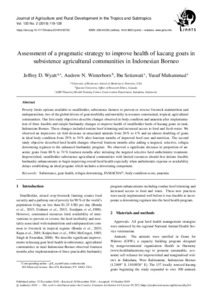Aufsatz

Assessment of a pragmatic strategy to improve health of kacang goats in subsistence agricultural communities in Indonesian Borneo
Zusammenfassung
Poverty limits options available to smallholder, subsistence farmers to prevent or reverse livestock malnutrition and endoparasitism, two of the global drivers of goat morbidity and mortality in resource-constrained, tropical, agricultural communities. Our first study objectives describe changes observed in body condition and anaemia after implementation of three feasible and simple husbandry changes to improve health of smallholder herds of kacang goats in rural, Indonesian Borneo. These changes included routine hoof trimming and increased access to food and fresh water. We observed an impressive six-fold decrease in emaciated animals from 26% to 4% and an almost doubling of goats in ideal body condition from 29% to 54% after fourteen months of improved hoof care and nutrition. The second study objective described herd health changes observed fourteen months after adding a targeted, selective, refugia deworming regimen to the enhanced husbandry program. We observed a significant decrease in proportion of anaemic goats from 88% to 74% fourteen months after initiating the targeted selective herd anthelmintic treatment. Impoverished, smallholder subsistence agricultural communities with limited resources should first initiate feasible husbandry enhancements to begin improving overall herd health especially when anthelmintic expense or availability delays establishing an ideal program which includes a deworming component.
Zitierform
In: Journal of Agriculture and Rural Development in the Tropics and Subtropics (JARTS) Vol. 120 / No. 2 (2019-11-22) , S. 119-128 ; ISSN 2363-6033Zusätzliche Informationen
Gedruckte Ausg. im Verlag Kassel Univ. Press (www.upress.uni-kassel.de) erschienen.Sammlung(en)
Vol 120, No 2 (2019) (Journal of Agriculture and Rural Development in the Tropics and Subtropics (JARTS))Zitieren
@article{doi:10.17170/kobra-20191030733,
author={Wyatt, Jeffrey David and Winterborn, Andrew N. and Setiawati, Ibu and Muhammad, Yusuf},
title={Assessment of a pragmatic strategy to improve health of kacang goats in subsistence agricultural communities in Indonesian Borneo},
journal={Journal of Agriculture and Rural Development in the Tropics and Subtropics (JARTS)},
year={2019}
}
0500 Oax 0501 Text $btxt$2rdacontent 0502 Computermedien $bc$2rdacarrier 1100 2019$n2019 1500 1/eng 2050 ##0##http://hdl.handle.net/123456789/11369 3000 Wyatt, Jeffrey David 3010 Winterborn, Andrew N. 3010 Setiawati, Ibu 3010 Muhammad, Yusuf 4000 Assessment of a pragmatic strategy to improve health of kacang goats in subsistence agricultural communities in Indonesian Borneo / Wyatt, Jeffrey David 4030 4060 Online-Ressource 4085 ##0##=u http://nbn-resolving.de/http://hdl.handle.net/123456789/11369=x R 4204 \$dAufsatz 4170 7136 ##0##http://hdl.handle.net/123456789/11369
<resource xsi:schemaLocation="http://datacite.org/schema/kernel-2.2 http://schema.datacite.org/meta/kernel-2.2/metadata.xsd"> 2019-12-03T12:49:31Z 2019-12-03T12:49:31Z 2019-11-22 doi:10.17170/kobra-20191030733 http://hdl.handle.net/123456789/11369 Gedruckte Ausg. im Verlag Kassel Univ. Press (www.upress.uni-kassel.de) erschienen. eng Urheberrechtlich geschützt https://rightsstatements.org/page/InC/1.0/ subsistence goat health refugia deworming FAMACHA© body condition score anaemia 630 Assessment of a pragmatic strategy to improve health of kacang goats in subsistence agricultural communities in Indonesian Borneo Aufsatz Poverty limits options available to smallholder, subsistence farmers to prevent or reverse livestock malnutrition and endoparasitism, two of the global drivers of goat morbidity and mortality in resource-constrained, tropical, agricultural communities. Our first study objectives describe changes observed in body condition and anaemia after implementation of three feasible and simple husbandry changes to improve health of smallholder herds of kacang goats in rural, Indonesian Borneo. These changes included routine hoof trimming and increased access to food and fresh water. We observed an impressive six-fold decrease in emaciated animals from 26% to 4% and an almost doubling of goats in ideal body condition from 29% to 54% after fourteen months of improved hoof care and nutrition. The second study objective described herd health changes observed fourteen months after adding a targeted, selective, refugia deworming regimen to the enhanced husbandry program. We observed a significant decrease in proportion of anaemic goats from 88% to 74% fourteen months after initiating the targeted selective herd anthelmintic treatment. Impoverished, smallholder subsistence agricultural communities with limited resources should first initiate feasible husbandry enhancements to begin improving overall herd health especially when anthelmintic expense or availability delays establishing an ideal program which includes a deworming component. open access Wyatt, Jeffrey David Winterborn, Andrew N. Setiawati, Ibu Muhammad, Yusuf publishedVersion ISSN 2363-6033 No. 2 Journal of Agriculture and Rural Development in the Tropics and Subtropics (JARTS) 119-128 Vol. 120 </resource>
Die folgenden Lizenzbestimmungen sind mit dieser Ressource verbunden:
Urheberrechtlich geschützt

